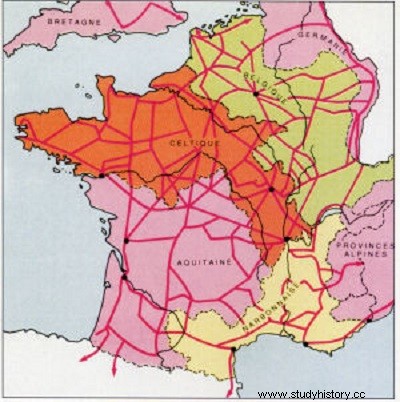
The conquest of Gaul by the Roman legions was greatly facilitated by a set of paths and roads, communication tools with multiple vocations (strategic, economic or cultural) between the cities of the Gallic peoples.
The old roads were gradually Romanized and, combined with the new roads, formed a network of routes starting from the capital, Lugdunum / Lyon (although the origin of these roads is Rome) towards all the capitals of the cities, which were also interconnected.
The four main axes starting from Lugdunum were:
The road to Germany to reach Colonia Traiana / Cologne,
The road to Italy to reach Rome,
The road to Boulogne-sur-Mer, port boarding for Brittany,
The Agrippa route known as the Aquitaine route:Lyon, Limoges, Saintes with its variant from Limoges to Burdigala / Bordeaux.
With their sense of organization, geometry and construction, the Romans, with the logistical support of a large number of soldiers, thus traced paths still often visible today on the ground or on maps. detailed.
The ancient documents that have come down to us do not allow us to precisely locate the Roman roads, we must look for other clues; and first of all, under our feet when we circulate, because nowadays, many Roman roads are covered by a modern axis, for example the RN7.
Mapping and aerial photos
Aerial prospecting and fine cartographic study make it easy to find traces of forgotten roads by their visible mark in the plot or the boundaries of municipalities.
The straightness of the route of a road, the presence of remote villages, succeeding ancient Roman villas (farms), often give a first indication.
Toponymy
Toponymy is also a source of information:place names like the path of Caesar, of course [ref. necessary], but also the roadway, the upper bollard, the railway, the white lane, etc. indicate the possibility of an important ancient route.
The Roman road was normally called in Latin via strata, or simply strata, that is to say gravelled, compared to the other paths which were not:we therefore have series of toponyms like Estrée(s) (with variants Estrat, Érat, Lestraz (Savoie)…), old word which corresponds to those designating the road, preserved by the current languages:street in English, straat in Dutch, Straße in German, strada in Italian…
The Maisons (-Alfort, -Laffitte, etc.) and especially the Maison-Rouges, which keep the memory of the old mansiones, are also very revealing.
Roman road can be part of an odonym, that is, an indicator of the type of road followed by a proper name. For example the Roman Way of Querilhac located in the town of Lafitte-Vigordane.
